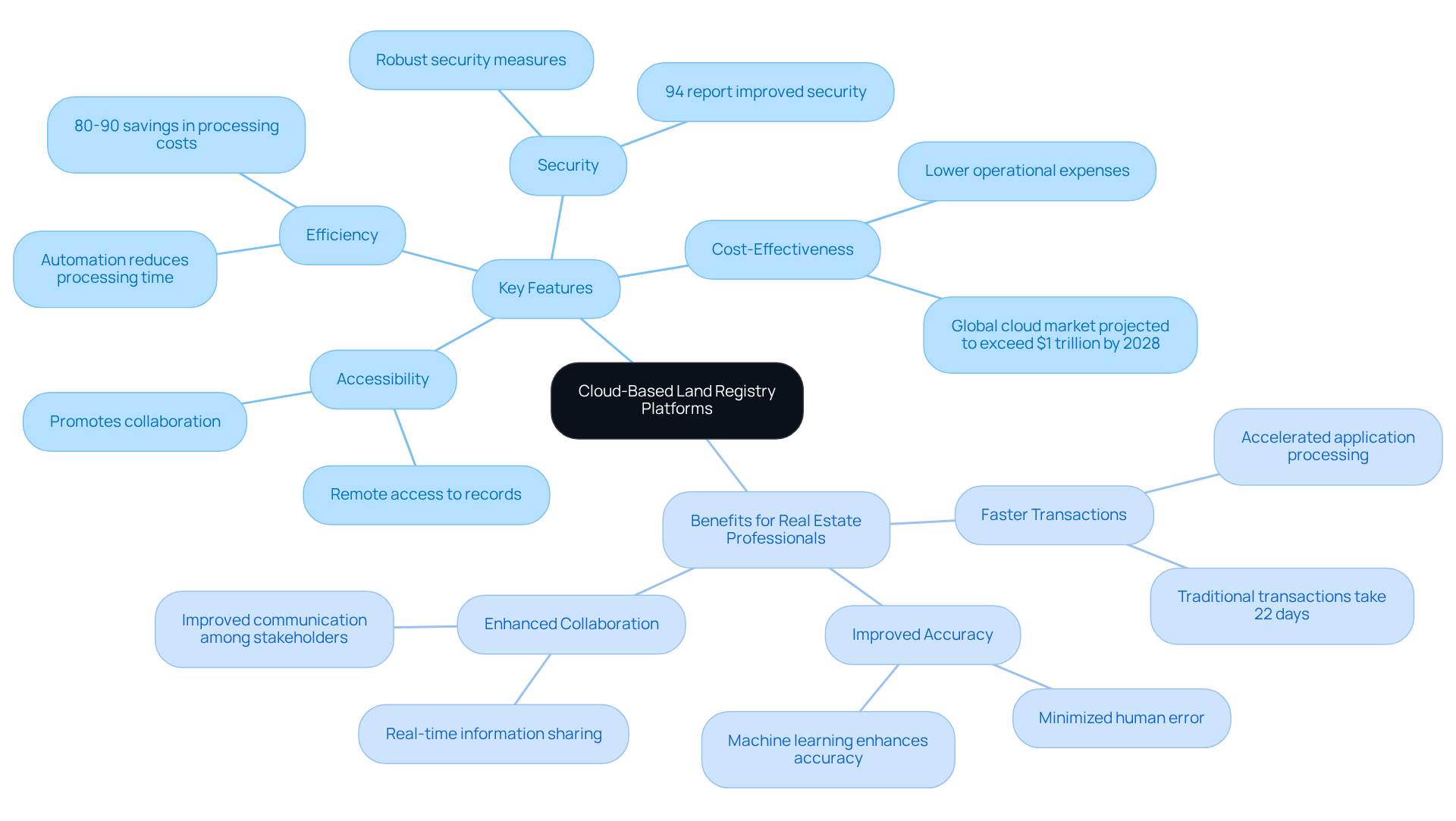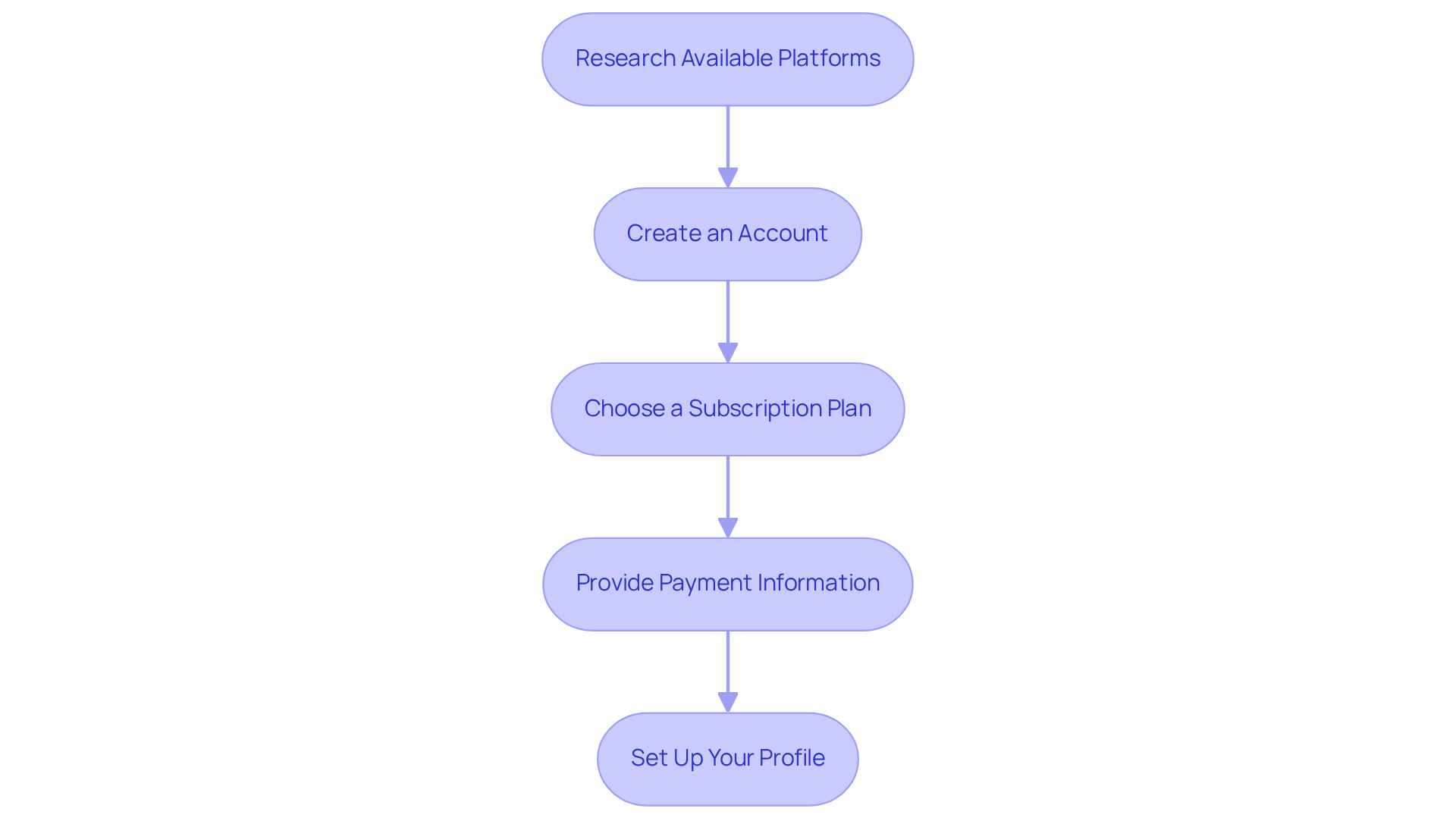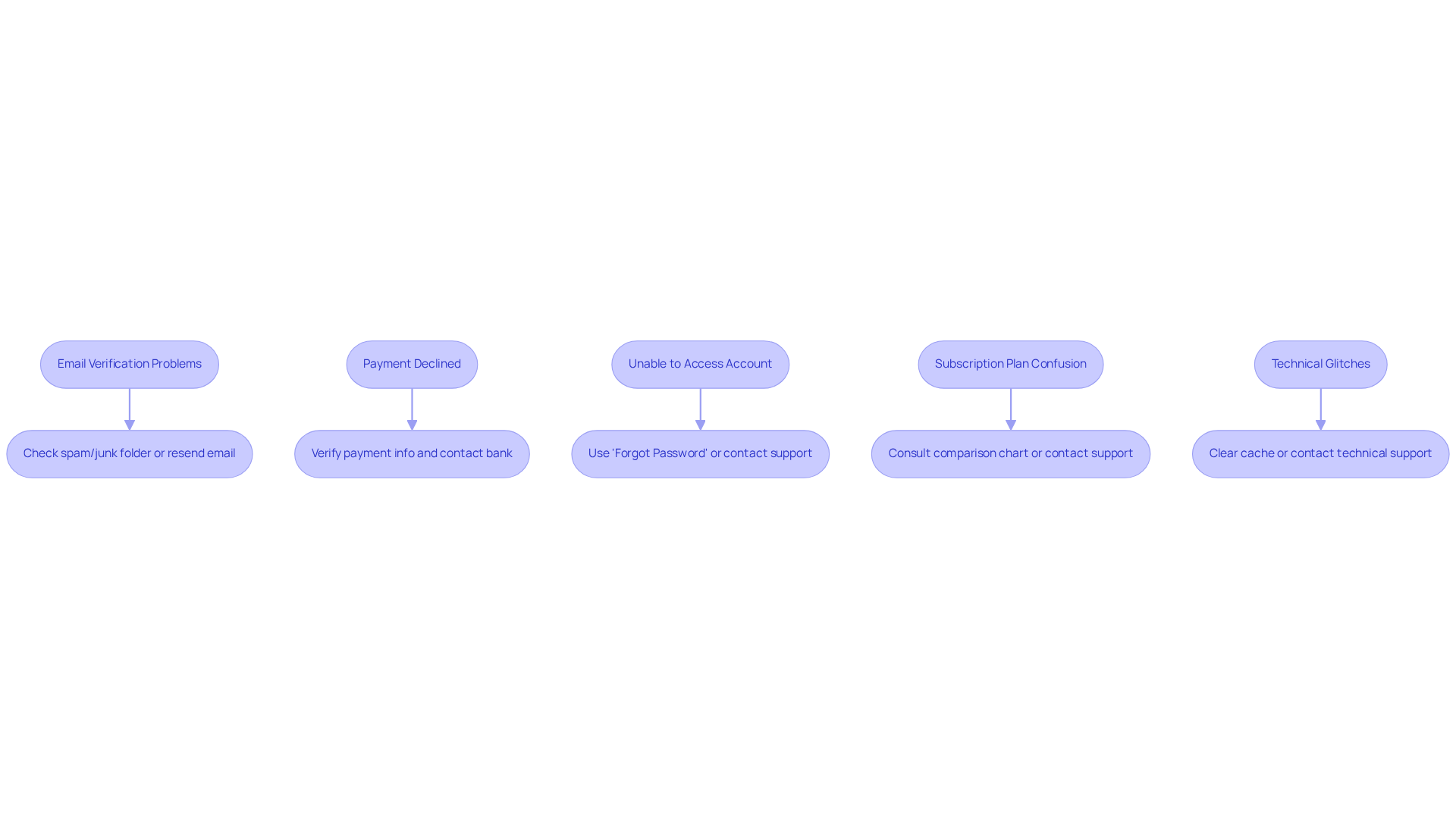Overview
Subscribing to a cloud-based land registry platform significantly enhances real estate operations by ensuring increased accessibility, efficiency, security, and cost-effectiveness. This article presents a comprehensive step-by-step guide for the subscription process, illustrating how these platforms effectively streamline property management tasks. Furthermore, they improve collaboration among stakeholders, ultimately leading to faster and more accurate transactions.
Introduction
The digital landscape is rapidly transforming the management of land ownership, with cloud-based land registry platforms at the forefront of this evolution. These innovative systems not only enhance accessibility and security but also promise significant efficiency gains for real estate professionals. As organizations contemplate the transition, a critical question arises: what are the essential steps to successfully subscribe to such a platform, and how can they navigate potential pitfalls along the way?
This guide offers a comprehensive roadmap to subscribing to a cloud-based land registry platform, ensuring users unlock the full potential of this technology while effectively avoiding common subscription challenges.
Understand Cloud-Based Land Registry Platforms
To effectively manage land ownership records online, it is essential to subscribe to a , which serves as a secure digital repository. By leveraging advanced technologies such as machine learning and optical character recognition, these platforms streamline property registration and title transfer processes.
Key Features of Cloud-Based Land Registry Platforms:
- Accessibility: Users can access records from any location, promoting remote work and collaboration among stakeholders.
- Efficiency: Automation significantly reduces the time required for title searches and document retrieval, expediting transactions. Organizations implementing AI-based matching have reported savings of up to 80-90% in processing costs.
- Security: Robust security measures protect sensitive data from unauthorized access, enhancing trust in the system. In fact, 94% of businesses report improved security after migrating to the cloud.
- Cost-Effectiveness: By reducing reliance on physical infrastructure and manual labor, these systems can significantly lower operational expenses. The global cloud computing market is projected to exceed $1 trillion by 2028, underscoring the trend toward cost-efficient solutions.
Benefits for Real Estate Professionals:
- Faster Transactions: The rapid processing of applications and information retrieval accelerates real estate transactions, enabling professionals to serve clients more effectively. This efficiency is critical as real estate transactions can traditionally take an average of 22 days to complete.
- Improved Accuracy: Automated systems minimize human error, ensuring that records remain accurate and current, which is essential for compliance and decision-making. Industry leaders emphasize that machine learning plays a vital role in enhancing the accuracy of land registry systems.
- Enhanced Collaboration: Real-time availability allows various stakeholders to update and share information effortlessly, fostering improved communication and informed decision-making.
These features and benefits are essential for real estate professionals who want to optimize their workflows and elevate service delivery by choosing to subscribe to a cloud-based land registry platform through innovative technology.

Follow Subscription Steps for the Platform
To enhance your real estate operations, you should subscribe to a as it represents an efficient strategy. Follow this step-by-step guide to navigate the subscription process effectively:
Step 1: Research Available Platforms
- Identify Your Needs: Assess the essential features required for your business, including document management, user access levels, and integration capabilities with existing systems.
- Compare Choices: Evaluate various platforms by reviewing feedback and analyzing case studies that demonstrate their effectiveness in real estate management.
Step 2: Create an Account
- Visit the Platform’s Website: Navigate to the official website of your chosen platform.
- Sign Up: Click on the 'Sign Up' or 'Subscribe' button. Typically, you will need to provide your email address and create a password.
- Verify Your Email: Check your inbox for a verification email and follow the instructions to confirm your account.
Step 3: Choose a Subscription Plan
- Select a Plan: Most platforms provide various subscription tiers. Choose one that aligns with your budget and operational needs. If assistance is required, contact the customer success team to identify the best option for you.
- Review Terms: Carefully examine the terms of service and privacy policy to understand your rights and obligations as a subscriber.
Step 4: Provide Payment Information
- Enter Payment Details: Input your credit card or payment information to complete the subscription process.
- Confirm Payment: Ensure you receive a confirmation of your payment and membership, as this is essential for your records.
Step 5: Set Up Your Profile
- Complete Your Profile: Fill in any additional information required, such as your business name and contact details.
- Customize Settings: Adjust your account settings to suit your preferences, including notification settings and user permissions.
By adhering to these steps, you can ensure a seamless enrollment experience, enabling you to leverage the system's features effectively. As cloud-based solutions continue to dominate the real estate sector, it is beneficial to subscribe to a cloud-based land registry platform to achieve heightened efficiency and improved decision-making.

Troubleshoot Common Subscription Issues
Even with a straightforward subscription process, users may encounter various issues. Understanding these challenges is crucial for a seamless experience. Here are some common problems and effective solutions:
-
Issue 1: Email Verification Problems
- Solution: If you do not receive a verification email, first check your spam or junk folder. If it is not there, attempt to resend the verification email from the platform’s login page.
-
Issue 2: Payment Declined
- Solution: Ensure that your payment information is accurate. Verify that there are sufficient funds in your account. If the issue persists, contact your bank for assistance.
-
Issue 3: Unable to Access Account
- Solution: If you forget your password, utilize the 'Forgot Password' feature to reset it. If you remain unable to enter your account, contact customer support for additional help. A smooth login experience is essential; research indicates that 20% of users give up on their accounts due to access problems.
-
Issue 4: Subscription Plan Confusion
- Solution: If you are uncertain about the features included in your chosen plan, consult the platform’s comparison chart or contact their support team for clarification. Parse AI provides both monthly and annual membership options, along with a pay-as-you-go plan, enabling you to select the best fit for your needs. Clear communication about subscription features can prevent misunderstandings and enhance user satisfaction.
-
Issue 5: Technical Glitches
- Solution: Clear your browser cache or try accessing the platform from a different browser or device. If problems continue, report the issue to the system's technical support. Technical difficulties can hinder user experience; however, proactive troubleshooting can often resolve these issues quickly.
By being aware of these common issues and their solutions, you can navigate the subscription process more effectively and start leveraging the benefits when you subscribe to a cloud-based land registry platform.

Conclusion
Utilizing a cloud-based land registry platform represents a transformative step for real estate professionals striving for efficiency and accuracy in managing property records. By embracing this innovative technology, individuals and organizations can significantly streamline their operations, ensuring secure and accessible management of land ownership data.
The article highlights the essential features of these platforms, including enhanced accessibility, efficiency, and security, which collectively contribute to a more effective real estate transaction process. Key benefits such as:
- Faster transactions
- Improved accuracy
- Enhanced collaboration
underscore the importance of adopting cloud solutions to optimize workflows and elevate service delivery. Furthermore, the step-by-step guide provided simplifies the subscription process, making it approachable for users at all levels.
As the landscape of real estate continues to evolve, the shift towards cloud-based solutions is not merely a trend but a necessity for those aiming to remain competitive. Embracing these platforms can lead to significant cost savings and operational improvements. Therefore, subscribing to a cloud-based land registry platform is not just a strategic move but a vital investment in the future of real estate management.
Frequently Asked Questions
What is a cloud-based land registry platform?
A cloud-based land registry platform is a secure digital repository for managing land ownership records online, utilizing advanced technologies such as machine learning and optical character recognition to streamline property registration and title transfer processes.
What are the key features of cloud-based land registry platforms?
Key features include accessibility for remote access, efficiency through automation that reduces processing time, robust security measures to protect sensitive data, and cost-effectiveness by lowering operational expenses.
How does a cloud-based land registry platform improve accessibility?
Users can access records from any location, promoting remote work and collaboration among stakeholders.
What efficiency benefits do cloud-based land registry platforms provide?
Automation significantly reduces the time required for title searches and document retrieval, expediting transactions, with organizations reporting savings of up to 80-90% in processing costs.
What security measures are in place for cloud-based land registry platforms?
These platforms implement robust security measures that protect sensitive data from unauthorized access, with 94% of businesses reporting improved security after migrating to the cloud.
How do cloud-based land registry platforms contribute to cost-effectiveness?
By reducing reliance on physical infrastructure and manual labor, these systems can significantly lower operational expenses, aligning with the projected growth of the global cloud computing market.
What benefits do cloud-based land registry platforms offer to real estate professionals?
Benefits include faster transactions, improved accuracy of records, and enhanced collaboration among stakeholders, allowing professionals to serve clients more effectively.
How do cloud-based platforms accelerate real estate transactions?
The rapid processing of applications and information retrieval allows for quicker completion of transactions, which can traditionally take an average of 22 days.
In what way do automated systems enhance accuracy in land registry?
Automated systems minimize human error, ensuring that records remain accurate and current, which is essential for compliance and decision-making, with machine learning playing a vital role in this enhancement.
How does real-time availability benefit collaboration among stakeholders?
Real-time availability allows various stakeholders to update and share information effortlessly, fostering improved communication and informed decision-making.




